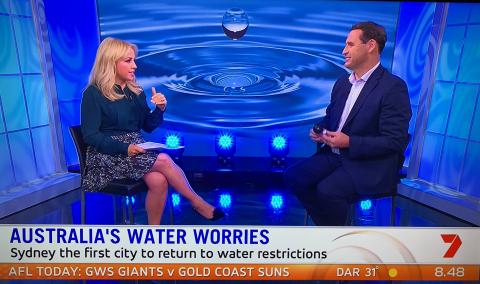We have all seen the pictures and the devastating impact of drought around Australia. It’s not only very dry (rainfall has been below average over very large areas for an extended period now) it is also very hot (we have just had the warmest January to April period on record for Australia).

Adam interviewed on Channel 7 Sunrise recently about Sydney's water restrictions.
Rainfall has been below average over very large areas of Australia for an extended period and the BOM says we are heading for a warmer and drier winter.
Our cities are experiencing some of the driest conditions on record. In Sydney dam levels are at 53.4%. That’s almost a 20 per cent drop in just 12 months. It’s not since the Millennium Drought (2001 to 2009) that dam levels have been this low in Sydney and level 1 water restrictions have just been announced. Similar conditions are occurring in other states as well.
We are fortunate in Australia that we have secure, clean, reliable and affordable water and wastewater services and the good news is we are better prepared than we were in the Millennium Drought. We have desalination plants (a climate independent source of water), there is more recycling of water, new technologies to help save water and our behaviours have changed and we use water more wisely. Because of this, the urban water sector emerged from the drought with a resilient, high-quality and diversified supply.
There are many current and future challenges - population growth, climate change, pricing, customer expectations, and funding for new and renewed infrastructure.
Diverse water supply options are the best insurance against climate change. Depending on which city you live in around Australia, the supplies contributing to water security will be different. But all cities have one thing in common – the equation includes more than just one source of water. It’s not just dams. It’s dams plus recycling plus desalination plus water efficiency programs. While some parts contribute more than others – they all contribute to a secure water supply.
Adam speaking to The Guardian about water security for Australia.
But there is still more to do to save water – and it’s time for another push to reduce how much water we use. The community has a critical role to play in times of drought and there are real choices that every individual can make for their own circumstance. For example when you purchase a dishwasher or washing machine look for the blue WELS efficient product label, make sure you have a water efficient showerhead to save on water and energy. For your garden and car, when you buy a trigger nozzle for your garden hose or other outdoor product look for the Smart Approved WaterMark label. It’s pleasing that the days of hosing down hard surfaces are well behind us, but we shouldn’t slip back into bad habits.
We use water every day - and it’s essential - but we often forget that we can make a difference and there is something everyone can do to save water as we face some of the driest conditions on record.
